 Koninklijke Marine Frigates: Frigate 66 Programme, Built 1971-76.
Koninklijke Marine Frigates: Frigate 66 Programme, Built 1971-76.HNLMS Tromp (F801), De Ruyter (F806), in service 1976-2001
The Tromp class frigates built for the Royal Netherlands Navy in 1970s were originally a replacement for the two De Zeven Provinciën-class cruisers and intended also to act as squadron flagships. Sharing many aspects with the British Type 82 destroyer (Bristol class) and they would have being originally given the British Sea Dart missile system, but this was changed later. They were notably recognizable by their prominent radome which had them nicknamed “Kojak”. They had British engines, US weapons and Dutch radars. These versatile ships combined the Standard SAM, Sea Sparrow and RGM-84 Harpoon. Entering service in 1975 and 1976 they served until 1999 and 2001.
They were also quite costly and their design was revised for the new Kortenaer class a success, but which did not boxed in the same category. They were replaced by the more capable De Zeven Provinciën-class frigates, four commissioned 2002-2005.
Development
In the mid-1960s, the core of the Dutch surface fleet comprised twelve “submarine chasers” (the Holland/Friesland class DDs), two cruisers of the Zeven Provinciën class and the aircraft carrier Hr.Ms. Karel Doorman. The carrier operated piston-powered aircraft, the cruisers, destroyers, and carrier were all primarily armed with Cannons and radars were still at the start of their development, and all sailed on steam. There were hardly any computers on board.
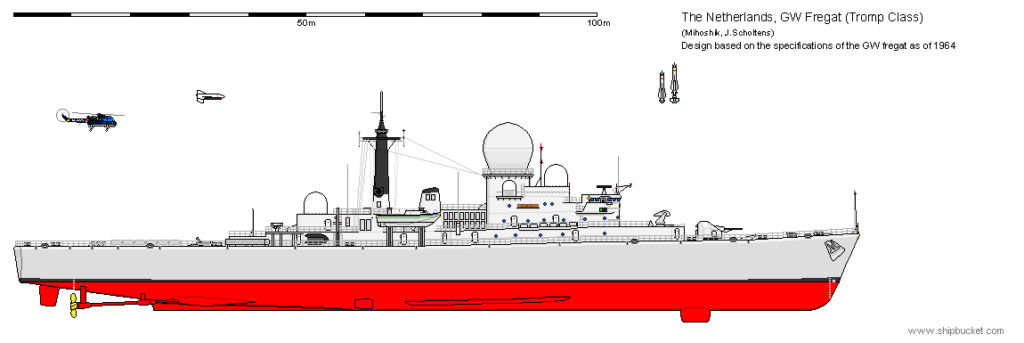
Shipbucket profile, GW Fregat 1964 program by MihoshiK, J. Scholtens. Note the forward Tartar and ASROC, French 100 gun. The aft deck was much larger.
Apart the six frigates of the Van Speijk class under construction and and receiving improvements, the Fleet’s equipment seemed outdated.
Technological developments reflected society changes, which accelerated and this all had an impact on the Dutch Navy, which planned two “capital ships” mostly tailored to replace the two cruisers as main escorts for the aircraft carrier, and they were to be revolutionary to embrace all the latest advances in warship tech at the time, as well as acting as proof of concept for future constructions.
This was also simple naval darwinism as the threat face also dramatically changed over the years. Surface ships had long range anti-ship missiles, jet aircraft as well, and guns were not just going to cut it. Developments in anti-ship missiles in the Soviet Navy, was well known withing NATO that gathered sufficient intel to be worried. Dutch radars at the time as well as the whole ship’s organization on board and afferent equipment were just too slow to answer a fast approaching missile. The firing systems aboard were also error-prone and too manpower-intensive. In 1967 the missile threat was exemplified as the destroyer INS Eilat was sunk by four Russian-made Styx missiles or P-15 Termit (SSN-2). Eilat had radars but just WW2 guns and could not react fast enough. She was hit by 3 direct hits. To further push on the automatization aboard, one driving motive was the sharply rising personnel costs.
Civilian servants saw their wages massively increase these years and the Navy had to follow or lost its recruitment targets. But each of the two cruisers, with its 1,000 crew members aboard, seemed very expensive. Just the artillery onboard and associated systems consumed 1/3 of their manpower alone. A smaller ship armed with missiles sure to hit, and automation was estimated to have a crew below half this number.
The missions given to the Navy changed as well. The post-colonial context diverged and shifted from the far East to the Atlantic Ocean and the Soviet threat. NATO waited for the Dutch Navy to take its share of the collective defensive burden against the Soviet Union. To integrated in these modern international fleets urged for a reliable propulsion, sufficient speed and extra power (for all new onboard systems).
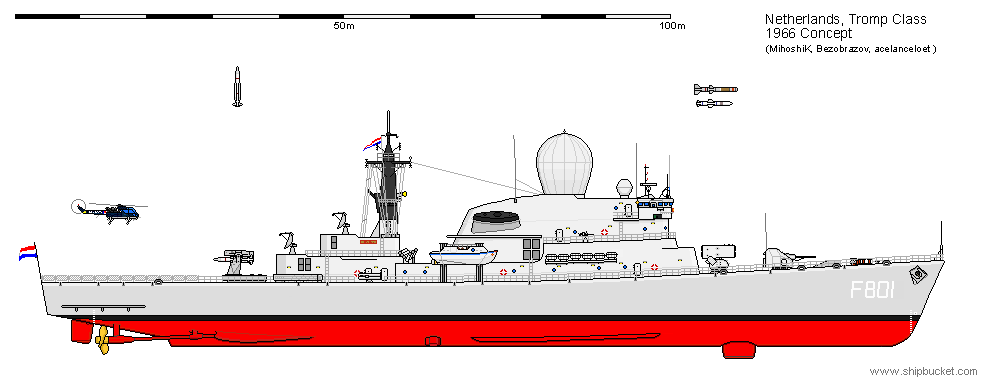
Shipbucket profile, GW Fregat 1966 concept by MihoshiK, J. Scholtens. Note the rear Tartar aft, ,o hangar, and forward ASROC, French 100 gun, funnels buried in the structure and towering bridge.
The sum of all these technological developments when specified on paper were a daunting task for the admiralty to concentrate on a single design, but also offered new opportunities. The Koninklijke Marine’s top brass did not shy away from these challenges.
In 1964, plans for two (later four) “destroyers” specialized for defense were announced by the Dutch MoD already, part of a naval plan also including nuclear submarines. Budget-wise it was rejected and the “destroyers” were recast as frigates as sounding less costly, but still capable to proved a strong air defense capacity and initialy to be provided a British anti-aircraft missile system and 3D radar under development. The radar was worked out in the Netherlands by HSA but also the British which were intyerested for a collaboration on this point, interested for a radar suitable for both their aircraft carriers and the Type 82 frigate. Given the reputation of Dutch electronics and RN involvment, Germany and France declared their interest.

Final aspect in 1996, shipbucket via seaforces.org, same authors as for the above profiles.
It was later agreed with the Royal Navy that the radar and software would be jointly developed in Britain but built in the Netherlands’s facilities at Hengelo. It was also signed that the new frigates would have the British Seadart missile system. But when the British white paper procognized to cancel their aircraft carriers, development of the radar took a hoit as its development stayed in limbo. To topple it out, the Sea Dart turned out to be below what the KM expected. The Netherlands would continue their 3D radar development alone from there.
Meanwhile Royal Navy Materiel Directorate (DMKM) prepared early designs in 1966, and some 40 variants and sub-variants had been proposed and sicussed already. Various research institutions such as TNO and the Dutch Ship Model Basin in Wageningen worked out hull shapes under the program “Frigate ’66”.
It was also agreed that there will not be any king of passive armor protection as it was the missile age, pleading for very long range engagement and active defense. Another important aspect that was worked out deeper was their flagship ability.
Construction
Wooden mockup were akso built in Soesterberg and at the Institute for Sense Physiology to work out ergonomics. Simulation equipment started to be built to train naval personnel despite initial skepticicism. The 1966 Defense Memorandum definitely solidified the two guided-missile frigates as firm replacement for the two cruisers. it had been five years before even a keel was laid down when construction started at last in 1971 for a completion in 1975 and starting service in 1976. By December 1970, official selection of the shipyard was conformed as the Koninklijke Maatschappij de Schelde, winner over the bid againsy Verolme. The navy wanted an experienced naval yard, but still submitted a tender.
Before construction started, however, the design had to be simplified due to escalating costs. It was done in gunnery, radio equipment, sonars, and CC displays as powerplant engineering. Still overall costs turned out tobe higher than planned at 556.8 million guilders for both frigates.
But that was to be expected. These ships were very innovative, groundbreaking for the KM, as they concentrated ion the same package, gas turbine propulsion for full speed and cruise, a central remote operation control to monitor these engines, a new type of central operation room, a new NBC protection system, an helicopter, and a missile armament with all the associated guiding systems and radars. The 3D radar in particular was unique and very advanced for the time. It was providing direction, distance as well target height and provided data to fire at two targets simultaneously, then two more immediately after they had been shot down.
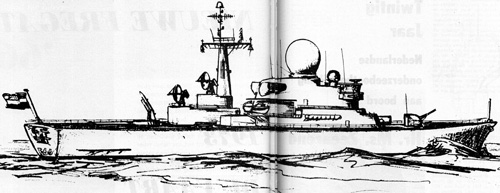
Frigate 1966 programme sketch. It would only enter service 9 years later and resembles the final design in some aspects albeit the hangar is missing. (Source: Alle Hens December 1966)
The “Broomstick program” common to the British Royal Navy and also Bundesmarine at first, was a true forerunner of NATO’s future collaborations. Many of the technologies which went into the British Type 82 destroyers (HMS Bristol) and it was also inspirational for the new Dutch Frigates, but in the end, its cost and association with a British guided missile system that was not on par with national expectations ended this collaboration. The choice of existing US weapons was done to avoid extra delays and rising costs.
Instead, the Kn.Marine decided to develop and purchase its own domestic sensor system while Germany went for a US radar. Due to extensive automation, these frigates managed to reduce their crew to c300, three times less than a cruiser. Their main task was still as squadron or escort for the carrier battle group and they can perform flagship missions as well with an extensive, additional communication/accommodation suite. They had large bridge well suited for a commander and his staff. They provided medium-range, short-range air defense, and anti-submarine defence for self-protection. In that they were radically different than anything the Navy built so far. Perhaps the closest European analogues at the time were the French Duquesne class Frigates which like the Tromp class, shared a conspicuous radome for their precious 3D radar.
Design of the class
Hull and general design
These frigates were comparatively larger than the ASW destroyers built until then, with an near-flush deck hull just cut at the stern under the helipad (also new). They displaced 3,665 long tons (3,724 t) standard for 4,308 long tons (4,377 t) full load. They measured 133.2 m (437 ft) overall in lenght, with a beam of 14.8 m (48 ft 7 in) and a draught of 6.6 m (21 ft 8 in).
Their profile was very unique. They had limited prow elevation and flare, anf a mostly equal-beam hull, roomy, with fine entry lines still.
The superstructures had to be roomy and extensive and the engineers had to made it lighter. Indeed later the ships needed to serve as flagships of two of the three anti-submarine task groups established in accordance with the 1974 Fleet Plan. But the broad hull-form with high freeboard was stabilized by weight savings coming from sea-water resistant aluminium alloy for the upper works, and non-retractable fin stabilizers combined with classis, but short counter-keels. Twin spade rudders were fitted along with their own electro-hydraulic steering gear, synchronized or usable independently.
In the end they managed to have excellent sea-keeping qualities, good internal volume and high level of habitability. They were caracterized by a long, extensive superstructure comorising a two-step forward section supporting the Sea Sparrow and Radar, then the three story tall main bridge, to act as flagship, but no open bridge. Two more radome guidance radars were installed on either side of the massive 3D radar under radome, the stocking feature of the design.
It was followed by open space (on which were later installed Harpoon canisters) and the two side by side funnels, sloped downards on either side to clear smoke out and fitted with heat reductors to reduce the infrared signature. Then followed a British style mainmast supporting smaller radars and antenane. The structure was on wto levels all along, with six lift rafts in canisters either side abaft the bridge and two service boats under davits under the funnels.
The aft structure supported two superfiring guiding radar for the Tartar and later MR-1 SAM. At their feet on the deck were installed two triple topredo tube ASW mark 48 launchers (installed later). After some free deck space, the aft superstructure was built, supporting the Tartar/Standard launcher and followed by the hangar, just large enough for a single Lynx helicopter. The stern section was occupied by the helideck. All in all, these were “busy” ships, but less than contemporary German destroyer designs for example.
Protection measures:
As said above, no armour was requested, however some ASW precautions were taken, with a full separations of machinery spaces for the two sets of gas turbines, extra comartimentation on either side and a double hull all along. To decrease underwater noise signature, all stringent noise were reduced as was all vibrating equipments, suspended. The machinery was resiliently mounted with silencers in uptakes and intakes in addition to heat reduction. The ship was built in NBC warfare in mind also, and there was a fully autonomous ventilation and air-conditioning system with individual control over all living and electronic spaces. All doors and hatches had full sealing, for the ships to evolve in a complete NBC closedown.
As for active protection, see notes below, notably flares and EW jamming systems.
Life aboard:
Designers managed to significantly reduce the crew with a core of 270 in a ship 138 meters long versus 256 on a Van Speijk class frigates which was 113 meters and much less than in cruisers. But combined with the large number of new systems on board the organization was to be made less complicated still, with many service areas reshuffled as “service groups” (Operational Service, Logistics Service and two others). This was unique at the time and clearer. The crew also benefited from better habitability and services, like more stewards at the cafeteria and individual beds. The extra automation and new organization led to also increased leizure time, and more joint activities can be organized. A ship’s newspaper was published and Disc jockey provided an onboard radio program from 6:30 AM to 7:30 AM. The net around the flight deck enable to organize volleyball competitions on Sunday. The first captain, Lohmeijer was surprised by the crew’s positive responsne and handling of the automation on board, taking confidently control of it as it had been normal. But these were young.
Sea trials went well until they entered service on October 3, 1975 and June 3, 1976 but issues soon arose with the use of aluminum for superstructures, despite it was quite common at the time. The combination of steel hull and aluminum structures posed structural issues, a vulnerability to fire and some vigration issues as well, plus a greater vulnerability in heavy weather. This combo was never used again in the KM. The weight of the heavy 12cm gun, 3D radar and hangar were really causing these structural issues. The ships were known to have excessive twisting, and seawater entered the developing cracks. The structures had to be repaired regularly, and the radome could be damage by bad weather or be rattled by fighter planes flying too close. But for sensors, weaponry and command they were among the best in Europe and could measure to any comparable ship internationally. By their appearance and capabilities they truly were closer to cruisers than frigates.
Powerplant
Technology in propulsion was also advanced in this design, parting from steam propulsion, which ensure to get fast, but was not flexible with many hours to prepare for departure while a Soviet attac on NATO would be lightning fast. Traditional steam turbines were also labor-intensive and automation was limited while maintenance was heavy and skills needed for it was lacking. For this design, alternatives such as gas turbine already used by other navies seems to work better and promised a lot of advantages, notably by being simpler, compact, lighter, taking more space inside for more efficience, they were less vulnerable, offering far more flexibility and better suited for remote and automated management with only ten to manage them. They were also silent and cleaner. Only drawback was its higher consumption and relative lack of experience. But it was still preferred since nuclear power was just out of question and it was used by British ships as well.
Crew reduction applied to the management of gas turbines and they came along with new controllable pitch propellers and diesel generators, all ideal for remote control and automation, all monitored and operated from the Central Technical Center. It was also tasked to fire fighting and damage control, as well as energy and water management among others. Push buttons replaced all older systems such as the telegraph and acoustic communication, this was mirrored on the bridge, with panels connected to each other. There were indication/warning lights instead of pointer instruments, making for a display of colorful, illuminated push buttons reminiscent of star trek’s enteprise control room and ultra-modern at the time. For veteran officers this was a huge change but some already saw this new style of monitoring as boring compared to the “grease & gauge checking” of old.
The four gas turbines worked in a combination called “Combined Gas or Gas” abbrviated as COGOG. These were two Rolls Royce Olympus gas turbines for the main fleet speed, up to 30 knots, and rated for a total of 54,000 hp (40,268 kW). This was completed by two smaller Rolls Royce Tyne gas turbine rated for 8,200 hp (6,115 kW), for cruising up to 18 knots (21 mph; 33 km/h). The two Olympus were in the forward engine room, the Tynes in the aft one to limited flooding issues. But if 30 knots was on paper, in reality to the Olympus turbines were downrated to improve gas-generator life and reduce maintenance to 28 knots (32 mph; 52 km/h) max, also out of concerns for vibrations and cracks developing in the superstructure.
Gas Turbines were not however always tthe best in terms of fuel economy, albeit the combination of low-pressure cruisre turbines helped to reach 5,000 nmi (9,300 km) at 18 knots (21 mph; 33 km/h), largely sufficient to escort the aircraft carrier far out in the Atlantic and back.
Armament
The armament consisted of two 120 mm guns, eight surface-to-air missiles, short- and medium-range surface-to-air missiles and anti-submarine torpedoes. There was an helipad for an helicopter aft, with hangar, also a first. A CIWS Goalkeeper system was later installed aft on it for anti-missile defence.
Tartar/MR-1 Mk.13 SAM launcher
The unique Mark 13 launcher was usabled for the Standard SAM (40 reload missiles), fitted aft on the superstructure, immediately before the helicopter hangar, at first lower than its 0° elevation line of fire. However the MR-2 was not available at first and in between, both ships were given the older Tartar RIM-24. Despite this was a single launcher, it was quick to reload and thus, was assisted by two guiding radars, to follow two vectors simultanoeusly. The Standard a whole family of medium-range air defense missiles, originally developed for the USN, which development started in the 1960s to replace the Tartar/Terrier with a single system. The improved Standard missile-2 came into use in the 1980s, tailored to work with Aegis. Since the whole Standard MR-1 module was similar to the Tartar, it was easy to do the sawp in 1984-85 to the RIM-66A.
The Dutch ships thus operated the Tartar from 1975-76 until 1984-85, less than ten years. They received the initial MR (Medium Range), without booster (replacing the Tartar). They were primarily a surface-to-air missile, not against ships as in the US variants. They started service on the Tromp class and later the Jacob van Heemskerck class frigates. The Dutch stuck to this weapons system choossing the SM-2 for the De Zeven Provinciën class frigates with plans to procure the SM-3.
⚙ specifications MR-1 RIM 66A 1967 |
|
| Weight | 1,240 lbs. (562 kg) |
| Dimensions | 13.5 x 176 in (34 x 447 cm), wp 42.5 in (108 cm) |
| Propulsion | Boost-sustainer rocket (Tartar Mark 27 motor) |
| Speed | Mach 3.5 (4,290 km/h; 2,660 mph; 1.19 km/s) |
| Guidance | Monopulse semi-active radar homing, inertial mid-course guidance. |
| Range/Ceiling | 35,000 yards (32,000 m) and 65,000 feet (19,800 m) max alt. |
| Accuracy | |
| Payload | 137 lbs. (62 kg) continuous rod |
*Solid-state electronics, battery powered.
1 x 8 Sea Sparrow SAM (16 RIM-7)
Installed on the forward superstructure, just aft of the main turret. It enabled the short range AA defence system, for aircraft missed by the MR-1. It was controlled by a small radar under radome right behind on the superfiring position. The sea sparrow were just entering US service at the time the Tromp class were completed, in 1976. It had been developed by Raytheon and General Dynamics. Delivered in two-arm four canister launcher it could deliver all these in a minute and incoming threats, flying to their targets at Mach 4. Shorter range meant shorter delays.
⚙ specifications RIM-7 Sea Sparrow |
|
| Weight | 510 lb (230 kg) |
| Dimensions | 12 ft x 8 in (3.7 m x 20 cm) wp 3 ft 4 in (1.02 m) |
| Propulsion | Hercules MK-58 solid-propellant rocket motor |
| Speed | 4,256 km/h (2,645 mph) |
| Range | |
| Guidance | |
| Range/Ceiling | 10 nmi (19 km) |
| Accuracy | |
| Payload | Annular blast fragmentation warhead, 90 lb (41 kg)* |
*Proximity fuzed, expanding rod, with a 27 ft (8.2 m) kill radius
Bofors 120 mm No.10 Gun Turret
One of the critics of the design for budget cutbacks was to recuperate the 120mm guns from former Holland class destroyer HNLMS Gelderland, decommissioned in 1974. These turrets were overhauled for reuse however. These twin Bofors 120 mm guns were capable of 45 rounds per minute. A joint-venture between Netherlands and Sweden like for the De Ruyter class cruisers and Swedish new destroyers, these were modern mounting, automated, fully stabilised with radar control so they were still not completely obsolete in the 1970s anthough more versatile systems like OTO Melara “super rapido” anti-missile/AA guns were now soon the norm in Europe.
Main 2×2 Bofors 120 mm/50
The Bofors 120 mm (4.7 in) Naval Automatic Gun L/50 or model 1950 was the first heavy twin-barreled fully automatic dual purpose naval gun turret system by Bofors. It was worked out already during WW2 as a private venture, and was relaiunched after a request by the Netherlands Navy in 1948. Development really went to fruition in 1951-54. The Swedish navy also adopted it.
In all, 720 rounds were stored per mounting in the hull below.
⚙ specifications Bofors 120 mm/50 |
|
| Weight | 67,000 kg (148,000 lb) |
| Elevation | -9°/+85°, 25°/s, traverse 360 at 22°/sec. |
| Loading system | Automatic extraction with integrated autoloader |
| Muzzle velocity | 835–850 m/s (2,740–2,790 ft/s) |
| Range | c12,000m |
| Guidance | Fire Control Radar |
| Crew | 2 (control) |
| Round | 120 × 835 mm R 23.35 – 23.5 kg |
| Rate of Fire | 2× 42 rounds/min |
8× Harpoon SSM
Two banks or four canisters, unarmoured, located on the upper deck right behind the main bridge’s radome 3D radar. They were elevated, and angled at about 100° towards the rear.
They formed the primary line of defence against ships, with the longest reach of all three weapons systems, 140 km. This was also a brand new weapons system, in service by 1977 and installed in their early years. Block I of course.
⚙ specifications RGM-84 Harpoon Block I |
|
| Weight | 1,523 lb (691 kg) including booster |
| Dimensions | 15 ft x 13.5 in (4.6 m x 34 cm), wp 3 ft (0.91 m) |
| Propulsion | Teledyne CAE J402 turbojet/solid propellant booster, 600 lbf (2,700 N) thrust |
| Speed | 537 mph (864 km/h; 240 m/s; Mach 0.71) |
| Range | 75 nmi (139 km) |
| Guidance | Radar altimeter, active radar terminal homing |
| Ceiling | Sea Skimming |
| Payload | HE warhead |
ASW Mk 32 TT (Mk 46 mod. 5)
Two triple bank, US built, manually operated (short 324 mm homing torpedoes), installed on deck either side of the aft structure and FCR.
The Mark 46 mod 5 torpedo was from a long family of compact ASW torpedoes, made for short range. Mod 0 was in service by 1963 and Mod 5 as the ships entered service in 1975. It was widely used by NATO and scores or countries across the globe. They were vectored in by the sonars after launch and then the actove or passive acoustic homing onars took in. Extremely reliable.
⚙ specifications Mark 46 Mod 5 TORPEDO |
|
| Weight | 508 lb (230 kg) |
| Dimensions | 8 ft 6 in x 12.75 in (2.59 x 323.8 mm) |
| Propulsion | 2-speed, reciprocating external combustion with Otto fuel II |
| Range/speed setting | 12,000 yd (11,000 m) 40 kn (74 km/h; 46 mph), 1,200 ft (370 m) depth |
| Warhead | 96.8 lb (43.9 kg) PBXN-103 HE |
| Guidance | Active or passive/active acoustic homing |
30mm/77 Goalkeeper
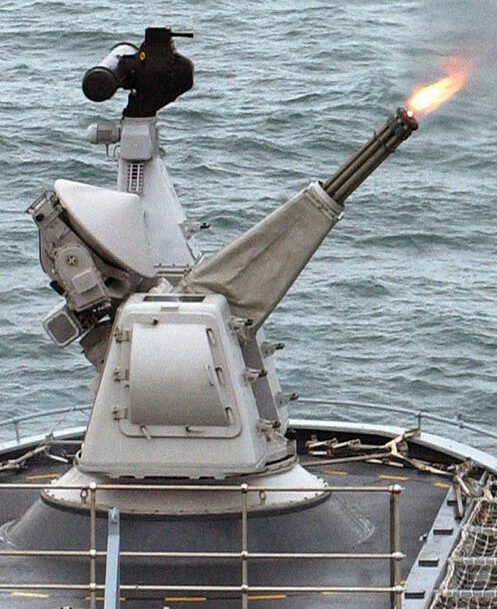
Installed in 1991 on De Ruyter alone. This was the default anti-missile CIWS system, installed on top of the hangar to have an excellent field of fire apart on missiles incoming directly on the ship’s axle from forward. This was a multitube arrangement, developed at home by Signaal (now Thales Nederland). In service by 1980 it was equivalent to the US CIWS but less conspicuous and integrated its own radar and firing system, all automated. Duel feed, the rounds were stored behind deck. Based on the GAU-8/A Avenger 30 mm cannon (A-10 Thunderbolt II). Features twice a smuch projectile mass as the Phalanx CIWS, and so a single hit was fatal. Each 30x173mm MPDS cartridge has a discarding nylon sleeve (sabot) with a 21 mm sub-calibre tungsten penetrator.
⚙ specifications Goalkeeper CIWS |
|
| Weight | 9,902 kg (21,830 lb) total, 6,372 kg (14,048 lb) gun alone. |
| Barrel lenght | 3.71 m above deck, total 6.2 m over and under deck. |
| Elevation/Traverse | +85 to −25° (80 degree/s |
| Loading system | Automated 7-barrel feed, 1,190 rds of ammunition above deck |
| Muzzle velocity | 1,109 m/s (MPDS round) |
| Range | 350-1,500/2,000 metres dependent on ammunition |
| Guidance | Radar guided, full auto tracking |
| Crew | Automated, with human oversight |
| Round* | 1.2 in or 30×173mm TP, HEI, MPDS, or FMPDS |
| Rate of Fire | 7-barrel rotary cannon GAU-8/A Avenger, 70 rps/4,200 rpm |
Air Group
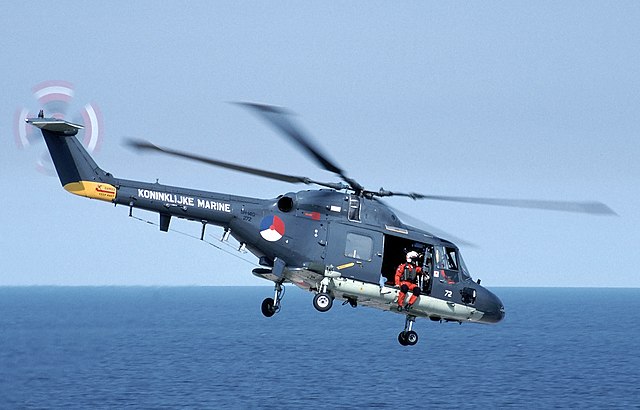
Both operated a versatile SH-14D Sea Lynx.
The The Royal Netherlands Navy’s as part of its Naval Aviation Service operated 24 Lynx over 36 years. They entering service at the same time as the Tromp class in 1976 phased out in 2012 (replaced by the EH-101). They were used for SAR, transport and ASW/ASUW, special forces tasks. They flew from the aft helideck of the Tromp class and had a hangar just large enough for maintenance. In 1993, this Lynx fleet was upgraded to the common Lynx SH-14D standard. One was lost in 1999 due to a rotor-head issue. All were temporarily grounded until retrofitted with new titanium rotor-heads.
⚙ SH-14D Sea Lynx specifications |
|
⚙ specifications |
|
| Displacement | 3,665 standard, 4,308 tonnes fully loaded |
| Dimensions | 138.2 x 14.8 x 4.60m (6.60 max) |
| Propulsion | COGOG 2 RR Olympus TM-3B gas turbines+ 2 RR Tyne RM-1C gas turbines 54000/8200 hp |
| Speed | Top 30, practiocal 28 knots, 19 knots cruising |
| Range | 600 tons oil, 5,000 nm at 18 kts |
| Armament | 1x Tartar SAM (40)/MR-2 SAM, 1×8 Sea Sparrow SAM (16), 1×2 120mm/50 Bofors, 2×3 324mm Mk 32 TT |
| Protection | |
| Sensors | 2x Decca 1226, SPS-01, WM-25, 2x SPG-51C radars, CWE-610, type 162 sonars, 2x Corvus decoy RL, SEWACO I CCS |
| Air Group | 1 helicopter SH-14D Sea Lynx |
| Crew | 305 |
 HNLMS Tromp (F 801)
HNLMS Tromp (F 801)

HNLMS Tromp was commissioned on 3 October 1975. By July 1976 Tromp, she operated with the frigates Van Nes, Van Galen, and destroyers Holland, Zeeland, submarine Dolfijn and replenishment ship Poolster for a large fleet exercise in the Atlantic culminating in a visit to New York in commemoration of the city’s 200 years anniversary of “Neeuw Amsterdam”.
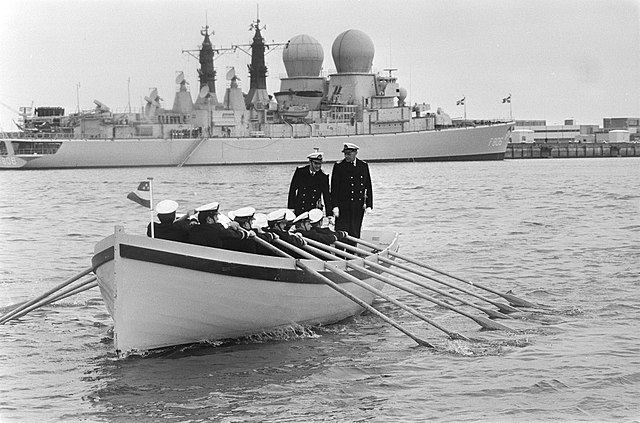
Transfer of the functions of Commander of the Naval Forces (BdZ) and also Chief of the Naval Staff by Vice Admiral B. Veldkamp to Rear Admiral H.L. van Beek. The outgoing commander B. Veldkamp is traditionally taken to shore by sloop. In the background the guided weapons frigate Hr. Ms. Tromp
On 12 March 1979 with HLMS Kortenaer, destroyer Drenthe and replenishment ship Poolster she made a long voyage in the Far East to show the flag, notably towards Indonesia and Sri Lanka among others.
In 1986 shortly after her first refit, she took part in NATO STANAVFORLANT ’86 and sailed to North America. But while underway, a fire broke out in the engine room. In 1986 the future King of the Netherlands Willem-Alexander served aboard.
On 8 February 1982 she departed with the frigates Callenburgh, Van Speijk, Piet Hein, and destroyer Overijssel as well as the replenishment ship Zuiderkruis from Den Helder to the US for another 200 years diplomatic relations celebration and back to to Den Helder on 19 May 1982.
In 1991 she had her last refit, with the addition of the Goadkeeper system.
In 1996 she visited Norway with the frigates Jacob van Heemskerck, Willem van der Zaan, Bloys van Treslong and replenishment ship Amsterdam.
In 1999 she was decommissioned, placed in reserve, later scrapped.
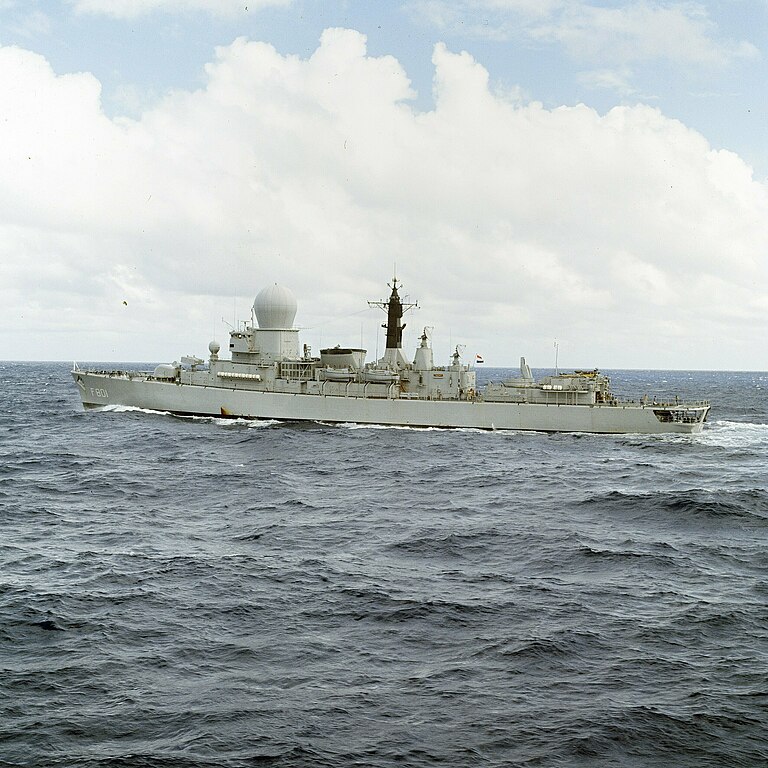
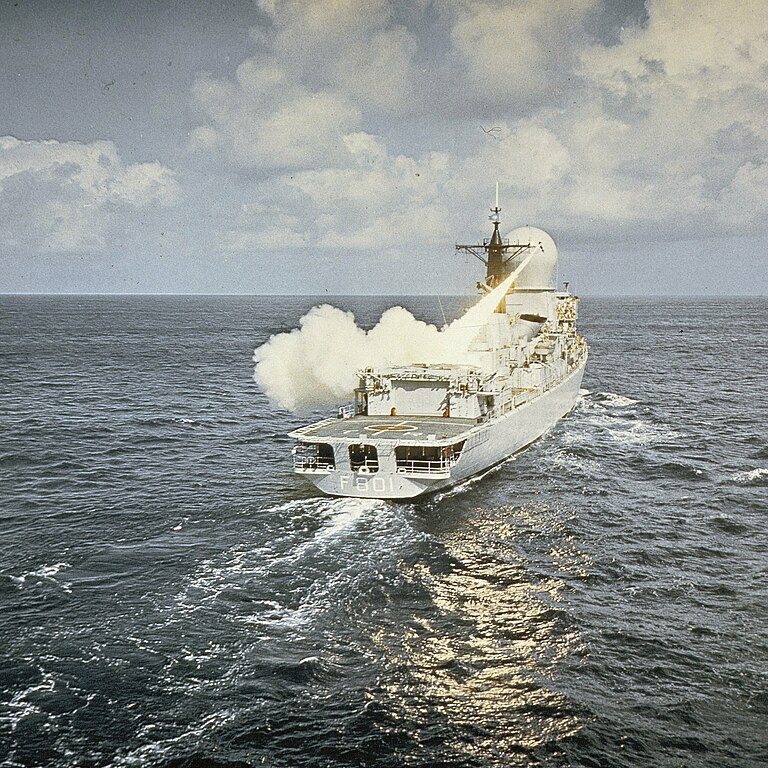
 HNLMS De Ruyter (F 806)
HNLMS De Ruyter (F 806)
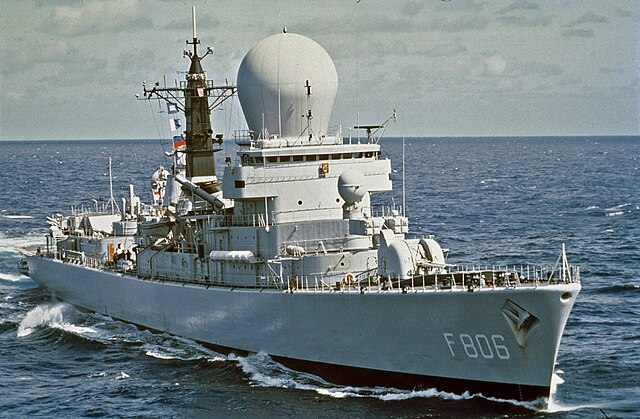
HNLMS De Ruyter entered service on 3 June 1976.
No records for 1976-86.
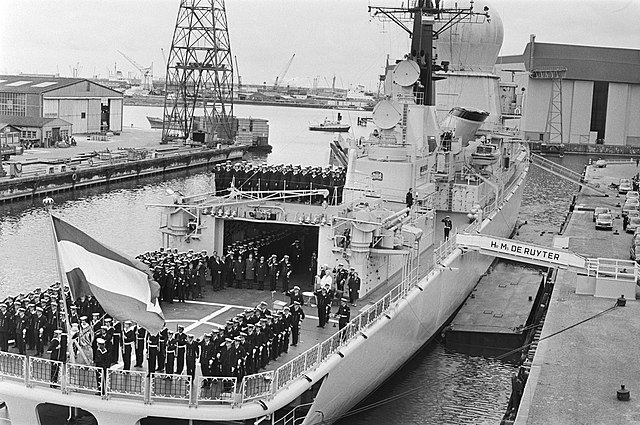
Commissioning ceremony
She departed with the frigates Callenburgh, Jan van Brakel, Van Kinsbergen and replenishment ship Poolster on 13 January 1986 for the Far East, to show the flag and promote Dutch trade, and back on 19 June to Den Helder Naval Base.
In the the mid-1990s she was part of Standing Naval Forces Mediterranean (STANAVFORMED), helping to enforce the ex-Yugiskavian coast embargo.
On 3 October 2001 she was decommissioned and later scrapped after some time in reseve.
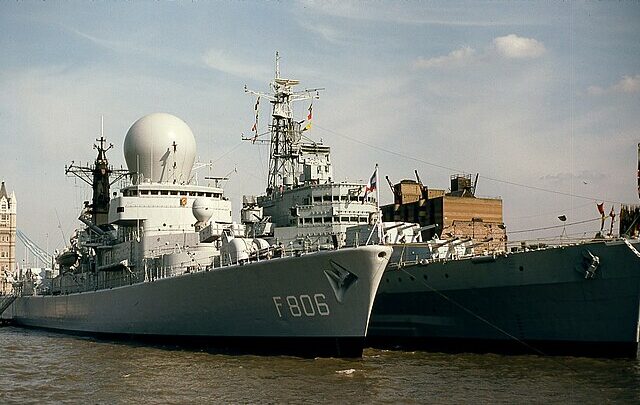
De Ruyter in London alongside HMS Belfast.
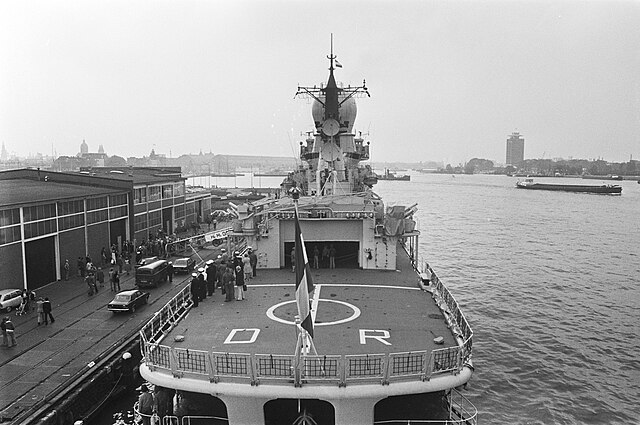
De Ruyter Helideck and hangar views
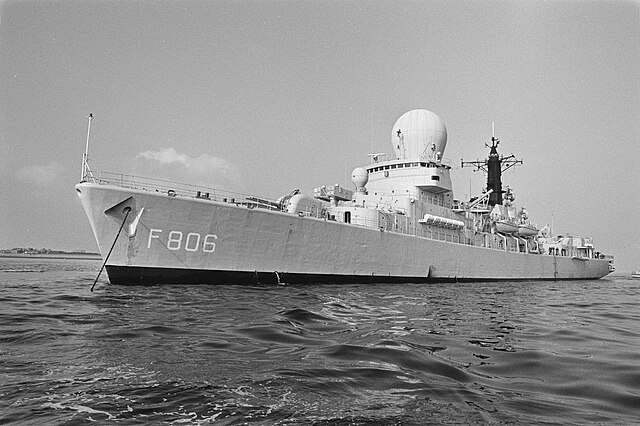
De Ruyter in Den Helder 1986
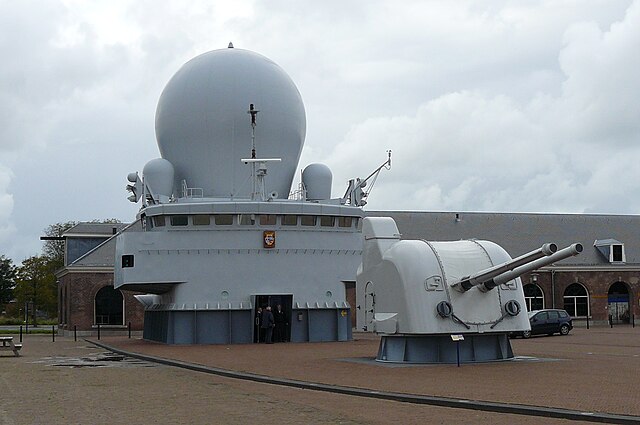
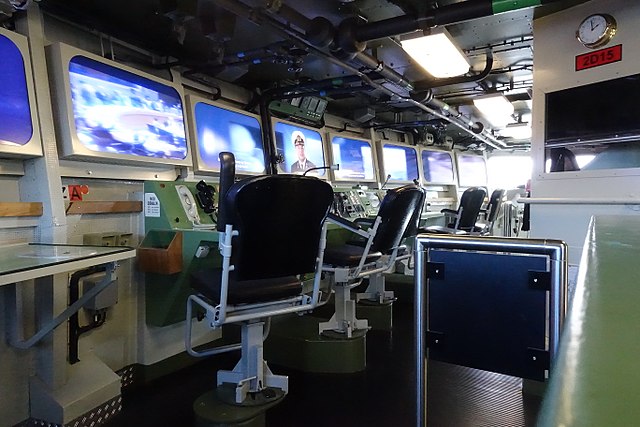

Her caracteristic bridge, radar and the forward turret of her sister were preserved however and now at the exhibition of the Navy Museum in Den Helder, Netherlands.
Read More/Src

Books
Conway’s all the world’s fighting ships 1947-95
Links
marineschepen.nl/ top article !!!
weaponsystems.net Tromp class
home.deds.nl deruyter
shipshub.com/
navypedia.org/
seaforces.org
modelbouwtekeningen.nl/
shipsnostalgia.com/
facebook.com/
navweaps.com Standard-1_MR_RIM66AB.php
nl.wikipedia.org Trompklasse_(fregat)
shipbucket.com
Videos
Model Kits
Naval Models, Koninklijke Marine Tromp klasse / GW-fregat MW 350-03 1:350 Full kit
3D
on shapeways.com for wargaming
Gallery




For all: Pinterest.


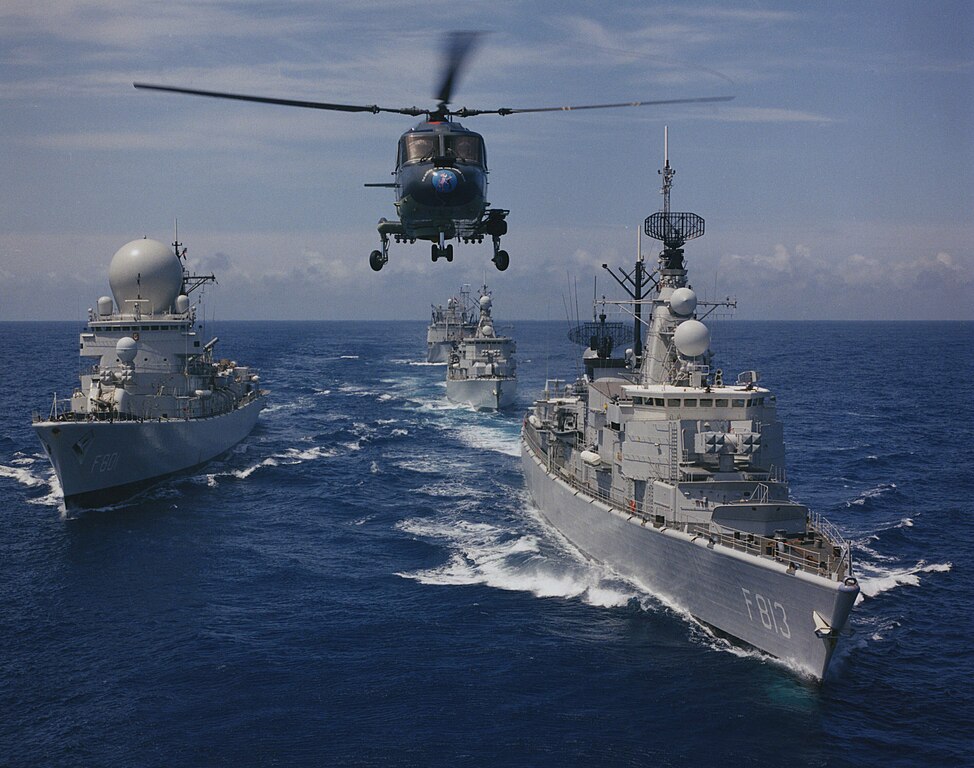
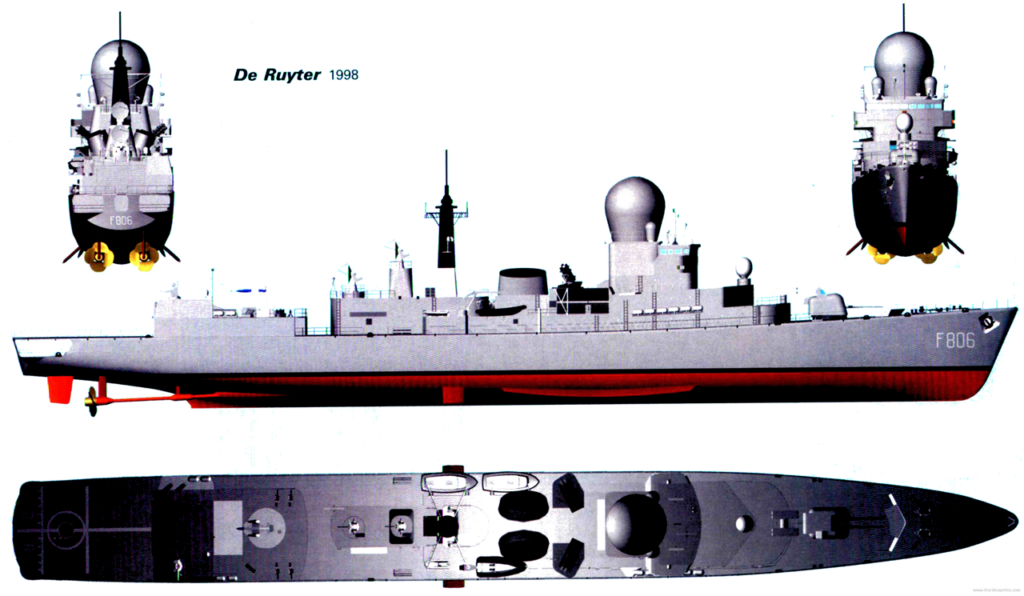
 Latest Facebook Entry -
Latest Facebook Entry -  X(Tweeter) Naval Encyclopedia's deck archive
X(Tweeter) Naval Encyclopedia's deck archive Instagram (@navalencyc)
Instagram (@navalencyc)





 French Navy
French Navy Royal Navy
Royal Navy Russian Navy
Russian Navy Armada Espanola
Armada Espanola Austrian Navy
Austrian Navy K.u.K. Kriegsmarine
K.u.K. Kriegsmarine Dansk Marine
Dansk Marine Nautiko Hellenon
Nautiko Hellenon Koninklije Marine 1870
Koninklije Marine 1870 Marinha do Brasil
Marinha do Brasil Osmanlı Donanması
Osmanlı Donanması Marina Do Peru
Marina Do Peru Marinha do Portugal
Marinha do Portugal Regia Marina 1870
Regia Marina 1870 Nihhon Kaigun 1870
Nihhon Kaigun 1870 Preußische Marine 1870
Preußische Marine 1870 Russkiy Flot 1870
Russkiy Flot 1870 Svenska marinen
Svenska marinen Søværnet
Søværnet Union Navy
Union Navy Confederate Navy
Confederate Navy Armada de Argentina
Armada de Argentina Imperial Chinese Navy
Imperial Chinese Navy Marinha do Portugal
Marinha do Portugal Mexico
Mexico Kaiserliche Marine
Kaiserliche Marine 1898 US Navy
1898 US Navy Sovietskiy Flot
Sovietskiy Flot Royal Canadian Navy
Royal Canadian Navy Royal Australian Navy
Royal Australian Navy RNZN Fleet
RNZN Fleet Chinese Navy 1937
Chinese Navy 1937 Kriegsmarine
Kriegsmarine Chilean Navy
Chilean Navy Danish Navy
Danish Navy Finnish Navy
Finnish Navy Hellenic Navy
Hellenic Navy Polish Navy
Polish Navy Romanian Navy
Romanian Navy Turkish Navy
Turkish Navy Royal Yugoslav Navy
Royal Yugoslav Navy Royal Thai Navy
Royal Thai Navy Minor Navies
Minor Navies Albania
Albania Austria
Austria Belgium
Belgium Columbia
Columbia Costa Rica
Costa Rica Cuba
Cuba Czechoslovakia
Czechoslovakia Dominican Republic
Dominican Republic Haiti
Haiti Hungary
Hungary Honduras
Honduras Estonia
Estonia Iceland
Iceland Eire
Eire Equador
Equador Iran
Iran Iraq
Iraq Latvia
Latvia Liberia
Liberia Lithuania
Lithuania Mandchukuo
Mandchukuo Morocco
Morocco Nicaragua
Nicaragua Persia
Persia San Salvador
San Salvador Sarawak
Sarawak Uruguay
Uruguay Venezuela
Venezuela Zanzibar
Zanzibar Warsaw Pact Navies
Warsaw Pact Navies Bulgaria
Bulgaria Hungary
Hungary

 Bundesmarine
Bundesmarine Dutch Navy
Dutch Navy Hellenic Navy
Hellenic Navy Marina Militare
Marina Militare Yugoslav Navy
Yugoslav Navy Chinese Navy
Chinese Navy Indian Navy
Indian Navy Indonesian Navy
Indonesian Navy JMSDF
JMSDF North Korean Navy
North Korean Navy Pakistani Navy
Pakistani Navy Philippines Navy
Philippines Navy ROKN
ROKN Rep. of Singapore Navy
Rep. of Singapore Navy Taiwanese Navy
Taiwanese Navy IDF Navy
IDF Navy Saudi Navy
Saudi Navy Royal New Zealand Navy
Royal New Zealand Navy Egyptian Navy
Egyptian Navy South African Navy
South African Navy






























 Ukrainian Navy
Ukrainian Navy dbodesign
dbodesign